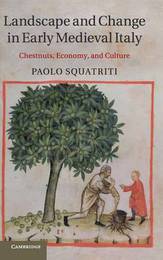
|
Landscape and Change in Early Medieval Italy: Chestnuts, Economy, and Culture
Hardback
Main Details
| Title |
Landscape and Change in Early Medieval Italy: Chestnuts, Economy, and Culture
|
| Authors and Contributors |
By (author) Paolo Squatriti
|
| Physical Properties |
| Format:Hardback | | Pages:252 | | Dimensions(mm): Height 229,Width 152 |
|
| Category/Genre | Human geography |
|---|
| ISBN/Barcode |
9781107034488
|
| Classifications | Dewey:333.73109450902 |
|---|
| Audience | | Professional & Vocational | |
|---|
| Illustrations |
4 Maps
|
|
Publishing Details |
| Publisher |
Cambridge University Press
|
| Imprint |
Cambridge University Press
|
| Publication Date |
16 May 2013 |
| Publication Country |
United Kingdom
|
Description
This innovative environmental history of the long-lived European chestnut tree and its woods offers valuable perspectives on the human transition from the Roman to the medieval world in Italy. Integrating evidence from botanical and literary sources, individual charters and case studies of specific communities, the book traces fluctuations in the size and location of Italian chestnut woods to expose how early medieval societies changed their land use between the fourth and eleventh centuries, and in the process changed themselves. As the chestnut tree gained popularity in late antiquity and became a valuable commodity by the end of the first millennium, this study brings to life the economic and cultural transition from a Roman Italy of cities, agricultural surpluses and markets to a medieval Italy of villages and subsistence farming.
Author Biography
Paolo Squatriti is Associate Professor of History and Romance Languages and Literatures at the University of Michigan. He specialises in the study of the pre-industrial environment and has published on ecological and landscape change in the Dark Ages.
Reviews'... densely laden as it is with relevant facts and observations, [this] book is a solid achievement, and its modestly presented thesis deserves to be appreciated beyond the niche of medieval arboreal history.' Jacob Wamberg, Speculum 'This book is an absolute treat, delicious in its detail, surprising in just how much a tree's view of medieval history can reveal about people. Paolo Squatriti's research on the rise of the chestnut, a tree little cultivated in the Roman period yet a major crop for medieval Italy, identifies the convergences between the worlds of men and woodlands. It is written with humour and intelligence, and nearly each page contains a discovery about botany, biology, cuisine or legal practice.' Caroline Goodson, Early Medieval Europe
|